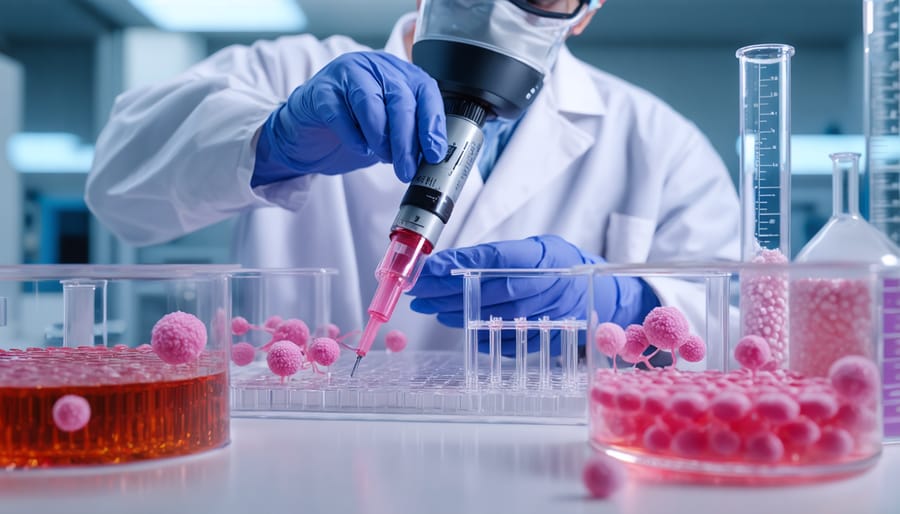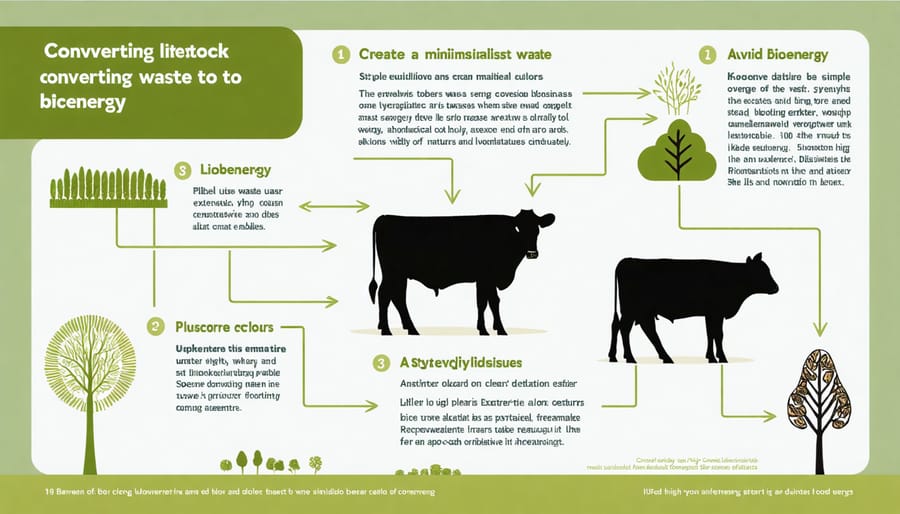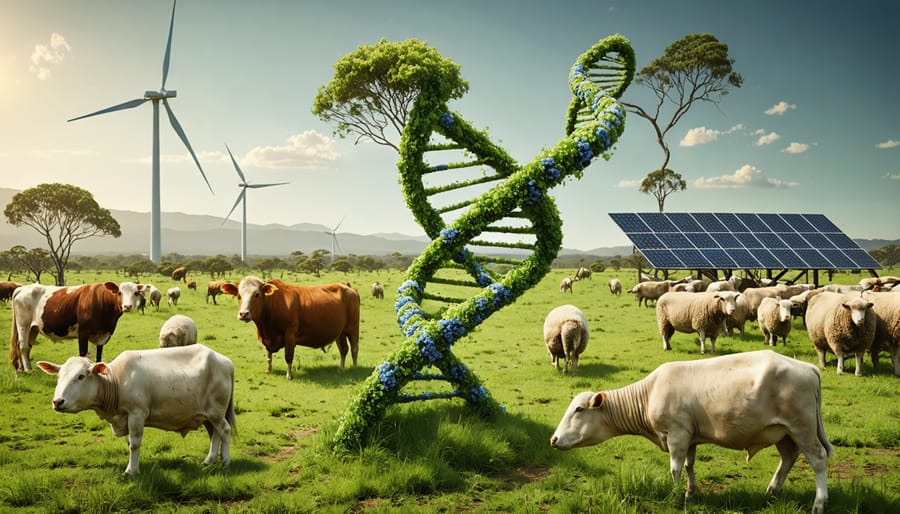Genetic engineering stands at the forefront of revolutionizing Australian livestock production, offering unprecedented solutions to our most pressing agricultural challenges. Through precise DNA modifications, farmers can now develop cattle with enhanced disease resistance, improved feed efficiency, and superior meat quality while supporting the benefits of bioenergy systems through optimized waste management.
This transformative technology represents more than scientific advancement; it embodies our commitment to sustainable farming practices while meeting growing global food demands. From drought-resistant sheep that thrive in Australia’s harsh climate to pigs engineered for reduced environmental impact, genetic modifications are reshaping traditional livestock management approaches.
Recent breakthroughs in CRISPR technology have made these improvements more accessible and cost-effective than ever before, allowing smaller farming operations to participate in this agricultural revolution. As we stand at this crucial intersection of technology and tradition, genetic engineering offers a pathway to more resilient, productive, and environmentally conscious livestock farming practices that will define Australia’s agricultural future.
Current State of Livestock Genetic Engineering in Australia

Key Technologies and Applications
In Australian livestock farming, several cutting-edge genetic engineering techniques are revolutionising the industry. CRISPR-Cas9 technology leads the way, allowing scientists to make precise modifications to animal DNA for improved disease resistance and productivity. This technique has been successfully applied to develop heat-tolerant cattle better suited to Australia’s harsh climate.
Gene editing through TALENs (Transcription Activator-Like Effector Nucleases) is another promising approach, particularly in sheep breeding programs aimed at enhancing wool quality and quantity. Australian researchers have also made significant progress with marker-assisted selection, which helps identify animals carrying desirable traits before breeding.
Recent developments include the use of RNA interference technology to boost immune responses in poultry and pigs, making them more resistant to common diseases. Additionally, transgenic techniques are being explored to produce livestock that can efficiently convert feed into protein, reducing environmental impact and improving farm productivity.
These technologies are carefully regulated under Australian guidelines, ensuring both innovation and safety in livestock genetic engineering. Current applications focus on creating more resilient animals while maintaining high welfare standards and environmental sustainability.
Regulatory Framework
In Australia, genetic engineering in livestock is governed by a comprehensive regulatory framework overseen by multiple authorities. The Office of the Gene Technology Regulator (OGTR) serves as the primary regulatory body, working alongside the Food Standards Australia New Zealand (FSANZ) to ensure the safety and compliance of genetic modifications in farm animals.
All genetic engineering projects must undergo rigorous assessment through a multi-stage approval process. This includes detailed environmental impact studies, animal welfare considerations, and food safety evaluations. Researchers and organizations must obtain specific licenses before conducting any genetic modification work, with regular audits and monitoring to maintain compliance.
The framework also incorporates strict containment requirements for modified animals and their offspring. Australian regulations emphasize transparency, requiring public consultation periods for new genetic engineering applications and maintaining an accessible database of approved projects.
Recent updates to these regulations have focused on streamlining processes while maintaining stringent safety standards, particularly for projects aimed at improving livestock sustainability and reducing environmental impact. The framework continues to evolve alongside technological advancements, ensuring responsible innovation in livestock genetic engineering.
Genetic Engineering for Enhanced Bioenergy Production
Optimizing Waste-to-Energy Conversion
Innovative genetic engineering techniques are revolutionizing how Australian farms transform livestock waste into clean energy. By modifying the gut microbiome of cattle and sheep, scientists have enhanced the efficiency of methane production, making waste-to-energy conversion more viable than ever before.
Recent breakthroughs have focused on optimizing the digestive processes of livestock to produce biogas with higher methane content. Modified gut bacteria help break down complex plant materials more effectively, resulting in waste that’s rich in energy-producing compounds. This genetic fine-tuning has increased biogas yield by up to 30% in some pilot programs across Queensland and Victoria.
Australian farmers are particularly excited about the development of “super-digester” livestock strains. These animals possess enhanced gut microbiota that not only improve feed conversion efficiency but also produce waste that’s ideally suited for anaerobic digestion. The result is a more streamlined and productive bioenergy generation process.
The benefits extend beyond energy production. Modified livestock produce waste with reduced environmental impact, lower odor emissions, and improved fertilizer potential. This creates a win-win situation where farmers can generate renewable energy while managing waste more effectively.
Looking ahead, researchers are working on new genetic modifications that could further optimize the waste-to-energy pipeline. These include developing livestock breeds with specialized gut microbiomes tailored to different types of feed and climate conditions, ensuring maximum energy extraction potential across Australia’s diverse farming regions.
This advancement in genetic engineering represents a game-changing approach to sustainable farming, offering both environmental benefits and new revenue streams for Australian agricultural enterprises.

Enhanced Feed Efficiency
Recent advances in genetic engineering have revolutionized how livestock convert feed into valuable protein, marking a significant breakthrough in sustainable farming practices. By modifying specific genes responsible for nutrient absorption and metabolism, scientists have developed animals that require less feed to achieve optimal growth rates.
A standout example is the development of enhanced digestive enzyme production in cattle and sheep, allowing them to break down traditionally hard-to-digest plant materials more efficiently. This modification has led to a remarkable 15-20% reduction in feed requirements while maintaining healthy growth rates. For Australian farmers facing frequent drought conditions, these feed-efficient animals represent a game-changing opportunity to reduce operating costs while lessening environmental impact.
The environmental benefits are particularly noteworthy. With improved feed conversion ratios, these genetically modified livestock produce fewer methane emissions per kilogram of meat or milk produced. Studies conducted across various Australian farms have shown that enhanced feed efficiency can reduce greenhouse gas emissions by up to 30% compared to conventional livestock.
Beyond environmental advantages, this technology offers significant economic benefits for farmers. The reduced feed requirements translate directly into lower production costs, making farming operations more resilient to feed price fluctuations and seasonal challenges. Progressive farmers implementing these innovations report annual feed cost savings of up to 25%.
Looking ahead, researchers are exploring new genetic modifications that could further improve feed utilization while enhancing animal welfare. These developments include traits for better heat tolerance and improved protein synthesis, particularly relevant for Australia’s diverse climate conditions. The combination of these advancements promises a future where livestock farming can be both more productive and environmentally sustainable.
Environmental Benefits and Sustainability Impact

Reduced Carbon Footprint
Genetic engineering in livestock presents a revolutionary approach to reducing carbon emissions from agriculture. By modifying specific genes, scientists have successfully developed cattle that produce up to 30% less methane during digestion, making a significant impact on greenhouse gas reduction.
These advances focus on altering the microorganisms in livestock’s digestive systems, particularly in cattle, which are responsible for methane production. Through precise genetic modifications, researchers have enhanced feed conversion efficiency, meaning animals require less food to produce the same amount of meat or milk. This improvement directly translates to reduced methane emissions per kilogram of product.
Australian research stations have demonstrated particularly promising results with modified sheep and cattle breeds. These animals not only produce fewer emissions but also show improved growth rates and better adaptation to our harsh climate conditions. For instance, a trial conducted in Queensland showed that genetically optimised cattle reached market weight 20% faster while producing 25% less methane throughout their lifetime.
The ripple effect extends beyond individual animals. With reduced feed requirements and improved efficiency, these modifications lead to decreased land use for grazing and feed production. This transformation helps preserve native habitats and reduces the overall environmental impact of livestock farming, creating a more sustainable future for Australian agriculture.
Resource Conservation
Genetic engineering in livestock has emerged as a game-changer for resource conservation in Australian agriculture. Through selective breeding and genetic modifications, farmers are achieving remarkable improvements in feed conversion efficiency, allowing animals to produce more meat, milk, or wool while consuming fewer resources.
Water usage, a critical concern in our drought-prone continent, has seen significant reductions through genetically optimised livestock. Modified cattle breeds now require up to 25% less water per kilogram of meat produced compared to traditional breeds. This advancement is particularly valuable in areas like Queensland and Western Australia, where water scarcity poses ongoing challenges.
Land use efficiency has also improved dramatically. Genetically engineered livestock can thrive on smaller parcels of land while maintaining or increasing production levels. For instance, modified sheep varieties can produce the same amount of wool on roughly 20% less grazing area, reducing pressure on natural ecosystems and allowing for land regeneration.
These improvements extend beyond direct resource usage. Enhanced disease resistance in engineered livestock reduces the need for extensive veterinary treatments and protective infrastructure, further minimising the environmental footprint of farming operations. Some modified breeds also show better adaptation to heat stress, requiring less energy for cooling systems in Australian conditions.
The combined effect of these advancements represents a significant step toward more sustainable farming practices, helping preserve our precious natural resources for future generations.
Future Prospects and Challenges
Emerging Technologies
The landscape of genetic engineering in livestock is rapidly evolving, with groundbreaking technologies reshaping the future of sustainable farming. CRISPR-Cas9 gene editing has emerged as a game-changer, offering unprecedented precision in modifying animal DNA to enhance disease resistance and improve feed efficiency. This technology is particularly promising for developing heat-tolerant cattle breeds suited to Australia’s challenging climate.
Scientists are also exploring novel bioconversion technologies that combine genetic engineering with waste management, enabling livestock to better process feed while reducing methane emissions. Recent developments in RNA interference (RNAi) technology show potential for creating animals with enhanced nutritional profiles and improved resistance to parasites.
Another exciting frontier is the development of sensor-integrated genetic markers, allowing real-time monitoring of animal health and genetic expression. This technology enables farmers to make data-driven decisions about breeding programs and health management. Australian researchers are at the forefront of developing gene drive systems that could help control invasive species while protecting native wildlife.
These emerging technologies are being developed with a strong focus on biosecurity and ethical considerations, ensuring that innovations in genetic engineering align with sustainable farming practices and environmental stewardship goals.
Implementation Barriers
While genetic engineering offers promising solutions for livestock improvement, several significant challenges need to be addressed for widespread adoption. The high cost of research and development remains a primary barrier, with sophisticated laboratory equipment and skilled personnel requiring substantial investment. Many Australian farmers, particularly those operating smaller properties, find these costs prohibitive.
Regulatory frameworks also present considerable hurdles. Current legislation surrounding genetically modified organisms requires extensive safety testing and approval processes, which can take years to complete. This lengthy timeline often discourages investment and delays the implementation of beneficial modifications.
Public acceptance continues to be a critical challenge. Consumer concerns about food safety and animal welfare influence market demand for genetically engineered products. Building trust through transparency and education is essential for overcoming these perceptions.
Technical challenges persist in achieving precise genetic modifications while avoiding unintended consequences. Scientists must ensure that beneficial traits are successfully passed to offspring without compromising other important characteristics.
Infrastructure limitations in rural areas can impact the delivery of genetic engineering services to farms. Additionally, the need for specialized training and ongoing support for farmers adopting these technologies creates logistical challenges.
Despite these barriers, ongoing research and technological advances are gradually making genetic engineering more accessible and acceptable. Success stories from early adopters are helping to demonstrate the practical benefits and safety of these innovations in livestock farming.
As we look to the future of sustainable agriculture in Australia, the integration of genetic engineering in livestock presents a game-changing opportunity for our bioenergy landscape. The potential to create dual-purpose farming systems, where livestock not only provides food but also contributes to renewable energy production, is within reach. By fine-tuning animal genetics to enhance methane production for biogas generation while maintaining or improving meat and dairy quality, we’re pioneering a new era of farm efficiency.
The success stories we’re seeing across Queensland and Victoria demonstrate that genetic engineering can help create more resilient livestock breeds that adapt better to our harsh climate while producing higher-quality biofuel feedstock. These advances are particularly promising for our remote communities, where sustainable energy solutions are desperately needed.
Looking ahead, the marriage of genetic engineering and livestock farming could transform our agricultural sector into a powerhouse of renewable energy production. We’re talking about farms that can power themselves, feed communities, and contribute to Australia’s renewable energy targets – all while reducing their environmental footprint.
The path forward is clear: by embracing these innovative technologies and continuing to refine our approaches, we can create a more sustainable future for Australian agriculture. With careful implementation and ongoing research, genetic engineering in livestock represents not just a solution to our energy challenges, but a blueprint for sustainable farming practices that future generations can build upon.

